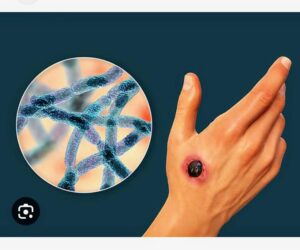By Aminat Umar

Anthrax is a serious infectious illness caused by the microbe Bacillus anthracis. This microbe resides in soil.
Anthrax became widely known in 2001 when it was used as a biological weapon. Powdered anthrax spores were sent via letters in U.S. mail.
This anthrax attack resulted in five deaths and 17 illnesses, making it one of the worst biological attacks in the history of the United States.
WHAT CAUSES ANTHRAX?
You can get anthrax through indirect or direct contact by touching, inhaling, or ingesting anthrax spores. Once anthrax spores get inside your body and activate, the bacteria multiply, spread, and produce toxins.
You can come into contact with anthrax through animals or biological weapons.
ANIMALS
Humans can get anthrax through:
Exposure to infected domestic or wild grazing animals
Exposure to infected animal products, such as wool or hides
inhalation of spores, typically during the processing of contaminated animal products (inhalation anthrax)
consumption of undercooked meat from infected animals (gastrointestinal anthrax)
Biological weapons
Anthrax can be used as a biological weapon, but this is very rare. There hasn’t been an anthrax attack in the United States since 2001.
WHY IS ANTHRAX SO DANGEROUS?
The Centers for Disease Control and Prevention (CDC)Trusted Source suggest that anthrax is one of the most likely agents to be used in a biological attack. This is because it’s easy to disseminate (spread) and can cause widespread illness and death.
Here are some other reasons why anthrax makes an effective agent for a bioterrorist attack:
It’s easily found in nature.
It can be produced in a lab.
It can last for a long time without stringent storage conditions.
It’s been weaponized before.
It can be easily released — in powder or spray form — without drawing too much attention.
Anthrax spores are microscopic. They might not be noticeable by taste, smell, or sight.
WHO’S AT RISK FOR ANTHRAX?
Despite the 2001 attack, anthrax is uncommon in the United States. It’s most often found in some farming areas in the following regions:
Central and South America
the Caribbean
southern Europe
Eastern Europe
Sub-Saharan Africa
Central and southwestern Asia
Anthrax illness is more common in farm animals than people. Humans have an increased risk of getting anthrax if they:
Work with anthrax in a laboratory
Work with livestock as a veterinarian (less likely in the United States)
Handle animal skins from areas
With a high risk of anthrax (not common in the United States)
Handle grazing game animals
Are in the military on duty in an
Area that carries a high risk of anthrax exposure
While anthrax can be transmitted to humans via contact with animals, it’s not spread through human-to-human contact.
WHAT ARE THE SYMPTOMS OF ANTHRAX?
The symptoms of anthrax exposure depend on the mode of contact.
Cutaneous (skin) contact
Cutaneous anthrax is anthrax contracted through contact with the skin.
If your skin comes into contact with anthrax, you may get a small, raised sore that’s itchy. It usually looks like an insect bite.
The sore quickly develops into a blister. It then becomes a skin ulcer with a black center. This doesn’t usually cause pain.
The symptoms typically develop within one to five days after exposure.
INHALATION
People who inhale anthrax usually develop symptoms within a week. But symptoms can develop as quickly as two days after exposure and up to 45 days after exposure.
THE SYMPTOMS OF INHALATION ANTHRAX INCLUDE:
Cold symptoms
Core throat
Fever
Achy muscles
Cough
Shortness of breath
Fatigue
Shaking
Chills
Vomiting
Ingestion
The symptoms of gastrointestinal anthrax usually develop within a week of exposure.
SYMPTOMS OF ANTHRAX INGESTION INCLUDE:
fever
loss of appetite
nausea
severe stomach pain
swelling in the neck
bloody diarrhea
HOW IS ANTHRAX DIAGNOSED?
TESTS USED TO DIAGNOSE ANTHRAX INCLUDE:
blood tests
skin tests
stool samples
spinal tap, a procedure that tests a small amount of the fluid that surrounds the brain and spinal cord
chest X-rays
CT scan
endoscopy, a test that uses a small tube with an attached camera to examine the esophagus or intestines
If your doctor detects anthrax in your body, the test results will be sent to a public health department laboratory for confirmation.
HOW IS ANTHRAX TREATED?
Treatment for anthrax depends if you’ve developed symptoms or not.
If you’re exposed to anthrax but you have no symptoms, your doctor will begin preventive treatment. Preventive treatment consists of antibiotics and the anthrax vaccine.
If you’ve been exposed to anthrax and have symptoms, your doctor will treat you with antibiotics for 60 to 100 days. Examples include ciprofloxacin (Cipro) or doxycycline (Doryx, Monodox).
Experimental treatments include an antitoxin therapy that eliminates the toxins caused by Bacillus anthracis infection as opposed to attacking the bacteria itself.
WHAT’S THE LONG-TERM OUTLOOK?
Anthrax can be treated with antibiotics if it’s caught early. The problem is that many people don’t seek treatment until it’s too late. Without treatment, the chances of death from anthrax increase. According to the U.S. Food and Drug Administration (FDA)Trusted Source:
The chance of death for cutaneous anthrax is 20 percent if it’s left untreated.
If a person has gastrointestinal anthrax, the chances of dying are 25 to 75 percent.
At least 80 percent of people die after inhaling anthrax without effective treatment.
HOW CAN I PREVENT ANTHRAX?
You can reduce your risk of anthrax by having the anthrax vaccineTrusted Source.
The only anthrax vaccine that’s approved by the FDA is the BiothraxTrusted Source vaccine.
When used as a preventive measure, it’s a five-dose vaccine series given over an 18-month period. When used after exposure to anthrax, it’s given as a three-dose vaccine series.
The anthrax vaccine isn’t typically available to the general public. It’s given to people who work in situations that put them at high risk of contact with anthrax, such as military personnel and scientists.
The U.S. government has a stockpile of anthrax vaccines in case of a biological attack or other type of mass exposure. The anthrax vaccine is 92.5 percentTrusted Source effective, notes the FDA.
Source: Healthline.com









